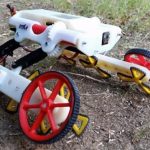
No, we won’t have a Blade Runner future: The robots of tomorrow won’t look like humans — we’re too inefficient
Saturday, December 09, 2017 by Frances Bloomfield
http://www.futuresciencenews.com/2017-12-09-no-we-wont-have-a-blade-runner-future-the-robots-of-tomorrow-wont-look-like-humans.html

In the 1980s science fiction classic Blade Runner, there exist human-looking robots known as replicants. These fictional biorobotic androids seem human on the surface yet possess strength, agility, speed, and resilience superior to ours. They’re also what many of us imagine the robots of the future will look like — as human as possible. Though according to Simon Watson, a Lecturer in Robotic Systems at the University of Manchester, that may not be the case as humans are “too inefficient.”
“We like to think that we’re the dominant creatures on the planet, so mobile robots should look like us. But the fact is, they shouldn’t,” wrote Watson in an article for Nanowerk.com. As he explained it, humans are incapable of flight, are unable to survive in a vacuum, and the majority of humans can’t travel for more than a mile without the aid of a car. To create humanoid robots is to indulge in little more than a “vanity project.”
Watson added: “Bipedal locomotion has served us well but it is limited and requires a huge amount of brain power and years of learning to perfect. The computer versions of our brain are nowhere near our level and are unlikely to be so for decades to come.”
One need not look any further than the 2015 Defense Advanced Research Projects Agency (DARPA) Robotics Challenge. On the first day of the competition’s final leg, many of the bipedal robots suddenly and unceremoniously fell over as they attempted to disembark from vehicles, open doors, and ascend stairs. In one memorable instance, Team AIST-NEDO’s HRP-2+ robot (the blue, yellow, and silver robot with fins on its head) lingered momentarily before a door then keeled over backwards.
So what will the robots of tomorrow look like? It would depend on what they’re being built for. “We adapt the technology to fit the environment. Rather than building robots that look like us so that they can be a direct replacement, you’ll start to see things being built to suit a problem,” said Watson. “Why do you need a robot with complex hands to pick up a pair of scissors or a hammer, when it can be built into their arms? Why build a robot to climb over debris in an earthquake on two legs, when four or six legs — or a wheeled track — would be much more stable?”
As the proverb goes, “Necessity is the mother of invention.” And if we need robots to, say, haul steel or transport people, then they’ll be built specifically and explicitly for those applications. No extra frills that could encumber them, nor additions that serve no purpose. (Related: Medical robot kills Ebola with UV light.)
Though Watson has acknowledged humanoid robots may become part of daily life, that won’t be for a long, long time. “You’ll pass them wandering down the street or hold a conversation with one as you do your shopping. But for now, the robots of the near future won’t walk like us. Instead they’ll drive, they’ll fly, they’ll swim, or they’ll walk on any number of legs — except two,” he concluded.
Read up on more stories about robots and artificial intelligence by visiting Robotics.news today.
Sources include:
Tagged Under: Tags: artificial intelligence, future tech, Glitch, research, robotics, robots, technology





